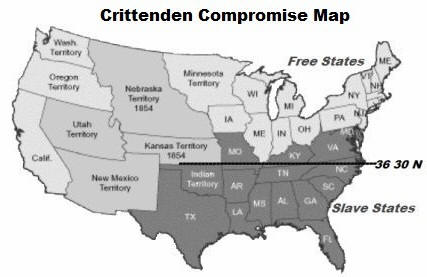| The Crittenden Compromise |
|
| Summary and Definition of the Crittenden Compromise of 1860
Definition and Summary: The Crittenden Compromise was proposed in Congress as a constitutional amendment on December 18, 1860, by Senator John J. Crittenden of Kentucky. The Crittenden Compromise assured the continuation of slavery in states where it already existed, in the hope of preventing the First State to Secede from the Union and the outbreak of Civil War. The Crittenden Compromise failed and was finally rejected two days before the inauguration of Abraham Lincoln. The Crittenden Compromise
James Buchanan was the 15th American President who served in office from March 4, 1857 to March 4, 1861. One of the key events towards the end of his presidency was the Crittenden Compromise. |
|
1860 Crittenden Compromise: Background History
On November 6th, 1860, the Abolitionist Abraham Lincoln was elected President of the United States representing the Republican Party, he would be inaugurated on on March 4, 1861. In the election, Abraham Lincoln carried all of the free states and none of the slave states. Just three days after learning of the Republican victory it was announced that a Convention of the People of South Carolina would be held on December 17th, 1860 in order to draw up an Ordinance of Secession and become the First State to Secede from the Union. Many hoped that the Secession of southern states might be stopped by some form of compromise. 1860 Crittenden Compromise: President Buchanan
President James Buchanan suggested an amendment to the Constitution that secured slavery in the slave-states and territories. However he knew that it was unlikely that neither the Republican party nor many of the southern states would agree to this suggestion. James Buchanan had earned himself the title of a 'lame-duck' president. He had failed to take a forceful stance with the threat of secession from South Carolina. His administration was in crisis and several members of his cabinet had resigned. Buchanan then authorized a ship full of reinforcements and supplies to Fort Sumter in Charleston Harbor. Carolinians fire on the ship but the President refuses to respond with force, deferring to Congress. Within a month the remaining members of his cabinet had all resigned. The most promising plan and compromise to put before the anti-slavery and pro-slavery political factions and avoid Civil War was proposed in Congress by Senator John J. Crittenden of Kentucky. Purpose of the Crittenden Compromise
The purpose of the Crittenden Compromise was therefore to appease the Southern states on the issue of slavery and avoid the secession of states in the south that would inevitably lead to Civil War. | | | Provisions of the Crittenden Compromise
John Crittenden proposed that amendments to the Constitution should be adopted. The provisions of Crittenden Compromise included: A constitutional amendment to guarantee the continued existence of slavery in the existing slave states The restoration of the boundary line drawn under the Missouri Compromise that prohibited the extension of slavery north of the 36°30′ latitude, as indicated on the map It advocated slavery in the District of Columbia The Fugitive Slave Laws were to be upheld, with minor modifications, and to pay the slave owners the value of runaway slaves It advocated suppression of the African slave trade To provide for the Doctrine of Popular Sovereignty in that states should be free or slave as their people determined Congress was forbidden to abolish slavery in places under its jurisdiction, such as a military post, within a slave state - refer to the Dred Scott Decision
| 
Crittenden Compromise Map |
|
Failure of the Crittenden Compromise: No Middle Ground
The failure of the Crittenden Compromise to reach a middle ground was perhaps inevitable. People were passionate on the issue of slavery, whether it was the Abolitionists in the north that wanted all slavery to be banned or the pro-slavery factions in the agricultural south who depended on the institution of slavery for their livelihoods. There was no middle ground. The Crittenden Compromise plan was carefully considered by Congress, and was finally rejected only 2 days before Lincoln's inauguration. The Crittenden Compromise: The Corwin Amendment
On March 2, 1861, another compromise called the Corwin Amendment was proposed by William Seward, passed by Congress and submitted to the state legislatures for ratification. It was an amendment to the Constitution as another last-ditch compromise effort to the south, protecting slavery in existing slave-states. The 1860 Crittenden Compromise: Abraham Lincoln
Abraham Lincoln took the decision to reject the Crittenden Compromise as unsustainable. Lincoln was satisfied with the Corwin amendment with the idea of guaranteeing the right of slavery in states where it existed, but insisted that the federal government could "entertain no proposition for a compromise in regard to the extension of slavery." By the time of the his inauguration on March 4, 1861, seven southern states had seceded from the Union and formed the Confederate States of America. The Crittenden Compromise had failed and Civil War began just over a month after Lincoln's inauguration on April 12, 1861 - refer to the Causes of the Civil War. The Corwin Amendment was never ratified - it was replaced by the 13th Amendment that completely abolished slavery. Crittenden Compromise - President James Buchanan Video
The article on the Crittenden Compromise provides an overview of one of the major issues of his presidential term in office. The following James Buchanan video will give you additional important facts and dates about the political events experienced by the 15th American President whose presidency spanned from March 4, 1857 to March 4, 1861. | | |
| |
|